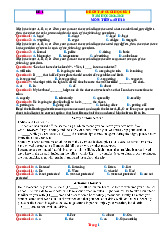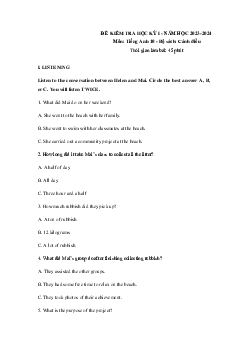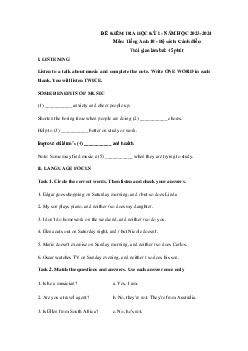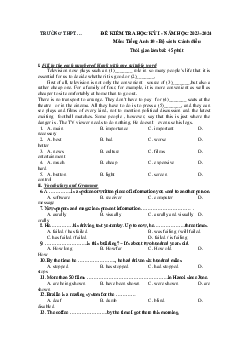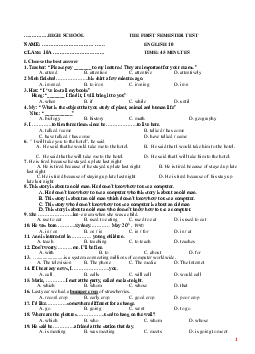







Preview text:
ĐỀ 7
ĐỀ KIỂM TRA CUỐI HỌC KỲ I MÔN: TIẾNG ANH 10 I. LISTENING: (2pts)
PART 1: For questions 1-5, listen and circle the correct answer A, B, C or D. You will
listen to the recording twice.
Question 1. What does the father want the son to do at the beginning of the conversation?
A. Take out the garbage
B. Do the family room. C. Know the rules.
D. Clean the bathroom.
Question 2. What is one thing the boy is NOT assigned to do around the house? A. Wash the walls. B. Vacuum the floors. C. Clean the garage.
D. Clean the baseboards
Question 3. What is the chore that the son is NOT doing in his bedroom?
A. Put away his toys. B. Make his bed. C. Pick up his toys D. Pick up his clothes.
Question 4. Where will the son go after completing the housework?
A. To the cinema. B.. To a ball game C. Out to eat
D. To a bookshop
Question 5. What will the father do while he does his work? A. sweep leaves B. plant trees
C. pull weeds. D. water flowers
PART 2: For questions 6 – 10, listen and decide whether the statement is TRUE or
FALSE. Tick (√) the correct boxes. You will listen to the recording twice.
Question 6. Toothpaste was invented about 1600 years ago.
Question 7. The earliest people used toothpaste were Ancient Greeks.
Question 8. Roman toothpaste used ingredients like crushed bones and oyster shells.
Question 9. The umbrella used to symbolise high social class.
Question 10. The umbrella was first used to protect people from the sun. II. LANGUAGE: (2pts)
PART 1: Mark the letter A, B, C or D on your answer sheet to indicate the word that
differs from the other three in the position of primary stress in each of the following questions.
Question 11. A. single B. access C. resource D. hardware
Question 12. A. appliance B. instrument
C. announcement D. invention
PART 2: Mark the letter A, B,C or D on your answer sheet to indicate the correct
answer to each of the following questions.
Question 13. Doing chores also helps develop children’s _________ to their parents. A. grateful B. gratitude
C. ungrateful D. gratefully
Question 14. The city council is responsible _______ keeping the streets clean. A. of B. about C. for D. to
Question 15. We were very _______ to help children organize after-school activities. A. exciting B. excited C. excite D. excitement Trang 1
Question 16. Too much carbon dioxide in the_________ can increase Earth’s average temperature. A. atmosphere B. family C. music D. contest
Question 17. She used to be a heavy smoker, but she _______ last year. A. made a decision
B. went on C. kicked the habit D. took up Question
18. Many people enjoy________ the news on their smartphones. A. read B. reads C. reading D. to read
Question 19. While I _____ home from school, it ______ to rain. I was so soaking wet! A. walk/ starts
B. walked/ was starting
C. was walking/ was starting
D. was walking/ started
PART 3: Mark the letter A, B, C or D to indicate the word OPPOSITE in meaning to the
underlined word in the following question.
Question 20. Artificial intelligence allows computers to copy human behavior. A. Natural B. Valuable C. Useful D. Man-made III. READING : (2pts)
PART 1: Read the following passage carefully and then choose the best option to fit
each numbered blank (from 21 to 25 ).
According to psychologists, most people do not realise the enormous benefits
(21)_______ come to a family when parents and children share the housework. Children who
share the housework with their mums and dads do better at school, become more sociable, and
have better relationships with their teachers and friends. They learn good skills, are more
(22)_______, and tend to be overall good people. When men share the housework, they tend
to have better relationships with their wives. Women often feel happy when they see their
husbands doing housework (23)_______ it says, 'He cares about me and he doesn't want to put
all of the housework on me.' Women whose husbands do not contribute (24)_______ the
household chores are more vulnerable to illness and (25)_______ to think more about divorce.
Question 21. A. whose B. whom C. who D. that
Question 22. A. irresponsible B. responsible C. irresponsibly D. responsibility
Question 23. A. because B. if C. while D. although
Question 24. A. to B. for C. in D. with Question 25. A. tend B. intend C. hope D. decide
(Unit 1 - Tieng Anh 10 - Pearson)
PART 2: Read the following passage carefully and then choose the best option to fit each
numbered blank (from 26 to 30 ).
Blues is a kind of slow sad music with strong rhythms. It was developed by
AfricanAmerican musicians in the American South. Early blues often took the form of a story
about the unkind treatment experienced by African Americans. Many elements of the blues
have grown from the music of Africa and religious music. Trang 2
The blues started at the end of the 19th century and the first blues sheet music appeared at
the beginning of the 20th century. Since then, it has developed into many styles such as
country blues and urban blues. Several decades later. electric blues with electrical equipment
replaced traditional blues. At the same time, the blues also reached a wider audience,
especially white listeners. A mixture of blues styles and rock music, called blues rock
appeared in the 60s and 70s of the last century.
(Source: workbook 10_Global success)
Question 26: What is the text mainly about?
A. The meaning of the blues. B. The start of the blues
C. Different styles of the blues. D. The start and development of the blues
Question 27: According to paragraph 1, the blues is a type of slow, sad music created by_______.
A. African-American musicians in the American South.
B. African Americans who like African and religious music
C. musicians in the American South
D. African Americans who experienced unkind treatment
Question 28 The word elements in paragraph 1 is closest in meaning to _______
A. roles B. forms C. parts D. sheets
Question 29: The word it in paragraph 2 refers to_______
A. the first blues sheet music B. the end of the 19th century C.
the blues D. the beginning of the 20th century
Question 30: Which of the following is NOT mentioned in the text?
A. Blues is a kind of slow sad music with strong rhythms
B. The blues was influenced by the music of Africa and religious music
C. Different styles of blues appeared, known as country blues and urban blues D. In the 1960s,
the blues reached a wider audience, including listeners in the Western Europe. IV. WRITING: (2pts)
PART 1: Choose the letter A, B, C or D to indicate the underlined part that needs correction (0,4 pt).
Question 31. Ms Lan was a teacher since she was 26 years old. A B C D
Question 32. I want to travel because I enjoy to meet people and seeing new places. A B C D
PART 2: Finish each of the following sentences in such a way that it means the same as
the sentence printed before it (0,6 pt).
Question 33. Ms Hoa began playing the piano in 2005.
→ Ms Hoa has __________________________________________________.
Question 34. Her parents don’t let her go out in the evening.
→ Her parents don’t allow _______________________________________________.
Question 35. The students clean the school playground every morning.
→ The school playground _________________________________________________. Trang 3
PART 3: In about 80 - 100 words, write a paragraph about ways to improve the
environment, following the guidelines below (1pt) - What activities they are
- How many students are involved
- How often these activities take place
- What your expected results are - ....... ------The end------
V. SPEAKING: (2,0 pts)
Students can choose one of these following topics to present: Topic
1: Talk about a volunteer work you would like to join You can use the following cues:
- What is the name of the volunteer work? - Where does it take place? - Who do you join with?
- Why do you take part in the volunteer work? - …
Topic 2 : Talk about your household chores. You can use the following cues:
- Family members’ responsibilities in your family.
- The chores you like doing most.
- The chores you dislike doing most.
- What benefits do you think you can get from sharing household chores? - … ĐÁP ÁN 1 2 3 4 D C D C 5 6 7 8 C T F F 9 10 11 12 T T C B 13 14 15 16 A C B A 17 18 19 20 C C D A 21 22 23 24 D B A A 25 26 27 28 A D A C 29 30 31 32 C D A C Trang 4 Câu 1 2 3 4 5 6 7 8 9 10 11 12 13 Đ. án D C D C C T F F T T C B A Câu 14 15 16 17 18 19 20 21 22 23 24 25 26 Đ. án C B A C C D A D B A A A D Câu 27 28 29 30 31 32 Đ. án A C C D A C WRITING:
Finish each of the following sentences in such a way that it means the same as the sentence printed before it (0,6 pt).
Question 33. Ms Hoa began playing the piano in 2005.
à Ms Hoa has played the piano since 2005
Question 34. Her parents don’t let her go out in the evening.
à Her parents don’t allow her to go out in the evening.
Question 35. The students clean the school playground every morning.
à The school playground is cleaned by the students every morning
PART 3 : HƯỚNG DẪN CHẤM BÀI VIẾT:
GV cho điểm mỗi thành phần ứng với mức độ nhận thức học sinh đạt được. Tổng: Nhận biết Thông hiểu Vận dụng Vận dụng cao 1 điểm Nội dung (0,1đ) - Trả (0,2đ) (0,3đ) (0,4đ) - Trả (0,4đ) lời ở mức tối thiểu - Trả lời được -
Trả lời khá lời đầy đủ yêu cầu yêu cầu của bài viết. cơ bản yêu cầu của đầy đủ yêu cầu của bài. Bài viết có Bài viết có câu chủ bài. Bài viết có câu của bài. Bài viết câu chủ đề. Các đề và các thành phần chủ đề. Các thành có câu chủ đề. thành phần cơ bản cơ bản. -Viết được 1
phần cơ bản đều được Các thành phần được phát triển kỹ, số ý chính nhưng có phát triển, đôi khi có
cơ bản được phát logic, cân xứng. chỗ diễn đạt không chỗ phát triển chưa triển tương đối - Đầy đủ, các rõ, bị lặp ý, không cân xứng. kỹ, logic và cân ý thống nhất, cod liên quan, gây khó - Viết được cơ xứng. liên quan chặt chẽ. hiểu cho người đọc. bản đủ ý chính. Có - Viết đủ ý - Dẫn chứng một vài ý không liên chính, các ý có hay và thuyết phục. quan, gây khó hiểu liên quan đến chủ cho người đọc. đề. - Dẫn chứng phù hợp, khá thuyết phục. Trang 5 Tổ chức NB (0,05đ) - TH (0,1đ) VD (0,15đ) - VDC (0,2đ) -
thông tin Thông tin bị lặp và -
Thông tin còn Thông tin ít khi Thông tin không và tính ảnh hưởng đến diễn bị lặp. bị lặp. bị lặp. liên kết đạt. - Sắp xếp các ý - Sắp xếp ý - Sắp xếp ý (0,2đ) -
Sắp xếp ý thiếu có logic, có tinh liên logic, mạch lạc, logic, mạch lạc cao. logic, thiếu tính liên
kết, mặc dù tính mạch dễ đọc, dễ hiểu. Bài viết có tổng thể kết. lạc giữa các câu còn - Sử dụng hài hòa, trôi chảy, tự nhiên. -
Ít sử dụng hoặc thấp hoặc máy móc. khá đa dạng và sử dụng lặp các - Sử dụng các chính xác các - Sử dụng đa phương tiện kết nối phương tiện kết nối phương tiện kết dạng và chính xác hoặc sử dụng tuy còn đơn giản nối. các phương tiện kết
cácphương tiện kết nối nhưng đúng nghĩa. nối. chưa chính xác. Từ vựng NB (0,05đ) - TH (0,1đ) VD (0,15đ) VDC (0,2đ) - (0,2đ) Từ vựng liên quan
- Từ vựng tạm đủ để
- Từ vựng đa Từ vựng phong
đến chủ đề hạn chế,
diễn đạt thông tin liên dạng có liên phú có liên quan lặp hoặc không phù
quan đến chủ đề. Một quan đến chủ đề. đến chủ đề, diễn hợp. số chỗ dùng từ chưa
- Có sử dụng từ đạt tự nhiên. Dùng - Dạng từ, chính tả phù hợp hoặc viết đồng/ trái từ phù hợp, chính còn viết chưa đúng, không đúng dạng từ. nghĩa, kết hợp xác. gây hiểu lầm cho
từ, thành ngữ,... -Sử dụng đa dạng người đọc.
-Ít lỗi sai về và chính xác các chính tả. phương tiện kết nối. Ngữ pháp NB (0,05đ) - Sử TH (0,1đ) -Sử VD (0,15đ) - VDC (0,2đ) (0,2đ)
dụng cấu trúc câu đơn dụng cấu trúc câu Sử dụng đa dạng -Sử dụng đa dạng, giản. khác nhau. các cấu trúc câu. linh hoạt các cấu
- Khá nhiều lỗi về ngữ - Nhiều lỗi về ngữ - Còn vài lỗi về trúc câu. pháp và gây khó hiểu pháp và gây khó hiểu ngữ pháp nhưng - Còn vài lỗi nhỏ về cho người đọc. cho người đọc.
người đọc vẫn có ngữ pháp. thể hiểu.
III/ HƯỚNG DẪN CHẤM NÓI
GV cho điểm mỗi thành phần ứng với mức độ nhận thức học sinh đạt được. Tổng: 2 điểm Nhận biết Thông hiểu Vận dụng Vận dụng cao Nội dung: 0,8đ (0,1đ) (0,2đ) -Trả lời (0,3đ) (0,4đ) -Trả lời ở mức
được yêu cầu cơ -Trả lời khá đầy -Trả lời đầy đủ
tối thiểu yêu cầu bản của đề bài: đủ yêu cầu của yêu cầu của bài: của bài: có 1 số khá đầy đủ ý bài: đủ ý chính, đủ ý chính, các
ý chính nhưng ý chính nhưng các ý thống ý thống nhất, có có thể chưa triển khai ý còn nhất, có liên liên quan, được được triển khai.
rời rạch hoặc có quan, được triển triển khai cân -Không có dẫn ý không khai nhưng có xứng. Trang 6 chứng hay dẫn liên quan. -Có chỗ chưa cân -Dẫn chứng phù
chứng chưa phù dẫn chứng xứng. hợp và thuyết hợp nhưng đôi chỗ -Dẫn chứng khá phục. dẫn chứng phù hợp và chưa phù hợp. thuyết phục. Độ lưu loát và (0,05đ) (0,1đ) (0,15đ) (0,2đ) liên kết phát -Gặp khó khăn -Cơ bản duy trì -Có khả năng -Nói lưu loát, âm(0,4đ) trong việc duy
tốc độ nói nhưng duỳ trì nói dài trôi chảy. diễn trì tốc độ nói.
còn nói vấp, nói dù đôi chỗ lặp, đạt mạch lạc, rõ
Nói vấp, nói lặp lặp hoặc nói sửa lại, và độ ràng hoặc nói chậm -
chậm -Biết phát lưu loát chưa -Phát âm tốt, dễ
Phát âm hạn chế, âm cơ bản, cao. nghe, dễ hiểu, còn nhiều từ có rất ít chỗ bỏ phát âm chưa nhưng độ chính -Biêt phát âm sót âm hoặc chuẩn, gây khó
xác chưa cao, từ khá tốt, kha dễ phát âm không hiểu cho người phát âm chưa nghe nhưng rõ ràng nghe. chuẩn, gây khó chưa hoàn toàn chính xác, hiểu cho người nhưng người nghe. nghe có thể hiểu được Từ vựng(0,4đ) (0,05đ) -Từ (0,1đ) (0,15đ) -Từ (0,2đ) vựng liên quan -Từ vựng liên vựng liên quan -Từ vựng liên đến chủ đề hạn
quan đến chủ đề đến chủ đề khá quan đến chủ đề chế, lặp hoặc cơ bản đủ để đa dạng để diễn phong phú, tự không phù hợp, diễn đạt -Biết nhiên gây khó hiểu đạt - Đôi chỗ cách sử dụng cho người nghe -Sử dụng đa cách nói khác dùng từ chưa dạng từ đồng để diễn đạt phù hợp nhưng nghĩa, trái người nghe vẫn nghĩa, rất ít lỗi có thể hiểu -Biết cách sử dụng từ đồng nghĩa, trái nghĩa, nhưng còn mắc lỗi
Ngữ pháp(0,4đ) (0,05đ) (0,1đ) (0,15đ) -Sử (0,2đ) -Sử dụng hầu -Sử dụng được dụng được đa -Sử dụng được hết các cấu trúc cả câu đơn, câu dạng các cấu đa dạng, linh câu đơn giản -
ghép, câu phức - trúc câu -Có ít hoạt các cấu Có nhiều lỗi ngữ lỗi ngữ pháp, Còn nhiều lỗi trúc câu pháp và gây khó đôi chỗ ảnh -Có ít lỗi ngữ hiểu cho người ngữ pháp, ảnh
hưởng đến ý cần pháp, nhưng nghe
hưởng đến diễn diễn đạt đạt không ảnh hưởng đến ý cần diễn đạt Trang 7
TAPESCRIPT FOR LISTENING: Part 1
Son: Dad. Can I go outside to play?
Dad: Well, did you get you Saturday’s work done? Son: Ah, Dad. Do I have to?
Dad: Well, you know the rules. No playing until the work is done. Son: So, what is my work?
Dad: Well, first you have to clean the bathroom including the toilet. And don’t forget to scrub the bathtub.
Son: No, I want to do the family room.
Dad: Well, okay, but you have to vacuum the family room and the hall, and be sure to dust everything. Oh,
and don’t forget to wipe the walls and clean the baseboards. [Okay.] And after that. [Oh, no.] Next, sweep
and mop the kitchen floor and be sure to polish the table in the living room. Son: Okay. Okay.
Dad: And make your bed and pick up all your toys and put them away. And . . . Son: More?
Dad: Yeah. And then, how about going out for lunch and getting a big milk shake, but you probably
don’t want to do that. Son: No, No. I want to.
Dad: Okay. While you’re doing your work, I’ll be out in the yard raking leaves and pulling weeds.
(Adopted from Randall’s ESL cyber listening lab) Part 2:
Hello, and welcome to “Fascinating Facts!” Today we’re going to take a look at some those ‘modern’
inventions which turn out to be … well, not quite so modern at all! Let’s start with toothpaste. So you think,
hmmm, toothpaste – when was that invented? A hundred years ago? Maybe two hundred? But we find that
actually, toothpaste has been around for sixteen hundred years. People from Egypt used it, and then the
Ancient Greeks and Romans used it. Was it the same as modern toothpaste? Definitely not. Ancient Greek
toothpaste used ingredients like crushed bones and oyster shells. OK, another invention for you: the good old
umbrella. If we look at a number of ancient sculptures from Egypt and Persia, which is now called Iran, it’s
clear that the umbrella has been around for a long, long time, certainly more than two thousand years,
Interestingly, it seems that only kings or very important people had umbrellas in these sculptures. So they were
a symbol of high social class. But what were they for? In Europe we tend to think of umbrellas as things to
protect us from the rain. But historically, they protected people from the sun. And later, they became a fashion
item. The next invention we are going to look at today is…. Trang 8
